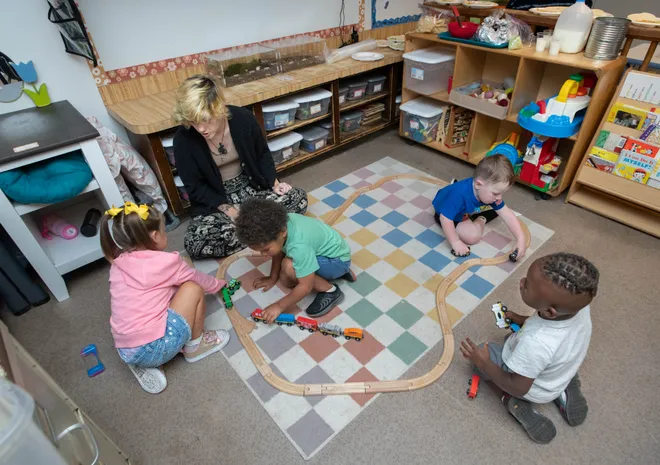Opinion: Child care costs widened the pay gap. Women in their 30s are taking the hit.
This month, the U.S. Census Bureau published a bombshell finding: The gender wage gap just got wider for the first time in two decades ‒ with women now earning just 83 cents to a man’s dollar.
That’s maddening. But, for moms at least, it’s hardly surprising. It’s next to impossible to balance work and family in this country ‒ and as this new data shows, women are taking the hit. As the cost of child care continues to soar, women will just keep falling further behind.
On paper, there’s no reason to believe that women should be earning less than men. Girls are more likely to graduate from high school and more likely to hold a bachelor’s degree.
More women than men go to law school and medical school, and women’s enrollment in MBA programs has reached record highs.
In fact, women do earn nearly as much as men ‒ at least early in their careers. On average, women in their late 20s and early 30s are much closer to parity, taking home at least 90 cents on the dollar compared with the guys sitting next to them at graduation or new hire orientation.
Then, when women hit their mid-30s, something changes. The pay gap gets wider. It’s no coincidence that that’s precisely when women are most likely to be raising kids. All of a sudden, women are forced to make very hard choices to manage the demands of work and family.
Motherhood penalty in the workforce is only getting worse

As the founder of Moms First, I’ve heard versions of this story from more women than I can count. Maybe mom drops down to part-time so she can make it to school pickup. Or maybe she switches to a new job that pays less but offers more flexible hours. Or maybe she drops out of the workforce entirely, because the cost of day care would have outpaced her salary anyway.
Make no mistake, we are talking about moms here. When women are paid less than men anyway (and, in the case of Black and Hispanic women, way less), deprioritizing their careers can feel like the only logical decision, even if it isn’t what they wanted.
This creates a vicious cycle, where pay inequity begets more pay inequity ‒ and women are systematically excluded from economic opportunities.
Opinion:Mothers cannot work without child care, so why aren't more companies helping?
At the same time, while women experience a motherhood penalty, men experience a fatherhood premium ‒ working more hours and reaping bigger rewards than those without kids.
As Nobel laureate Claudia Goldin put it, when describing her pioneering research on the pay gap, “Women often step back, and the men in their lives step forward.”
Because here’s the thing: The “choice” to step back from the workforce isn’t much of a choice at all. If grandma isn’t around to pitch in and child care costs more than rent, what other option do you have?
The cost of child care should be a central election issue
The problem is only going to get worse from here.
At home, moms are drowning ‒ with the U.S. surgeon general issuing an advisory cautioning against the present dangers to parents’ mental health and well-being. At work, diversity, equity and inclusion programs are under attack, denying women a fair shot to succeed.
Opinion:Parenting is overwhelming. Here's how one mom learned to cope.
After decades of glacially slow progress toward closing the pay gap, we’ve already backslid. I hate to imagine how much further we could fall. Especially when it’s so blindingly obvious what the solution is. If the lack of affordable and accessible child care is what’s holding women back, then we should make child care affordable and accessible.
To start, the business community can take action. When companies offer child care benefits, it’s not only a game changer for moms ‒ it’s a game changer for everyone. Offering these benefits pays for itself and generates a positive return on investment. If any other investment gave you these kinds of returns, it would be a no-brainer.
In this all important election year, we also need to demand that our lawmakers take bold, decisive action on child care. Policies like expanding the child tax credit, capping child care costs at 7% of working families’ income and paying caregivers a living wage are huge steps in the right direction. And it’s critical that our leaders continue to prioritize them.
We should take every opportunity to ask our candidates, up and down the ballot, how they plan to solve the child care crisis, and then we should hold them to their promises at the ballot box.

When I first began building the Moms First movement, a lot of people asked me: Why moms? Why not all parents? This is why.
Yes, the child care crisis hurts all of us, dads included. But moms are paying the price, in the most literal sense. We have to change that ‒ not just for our kids and families, but also for ourselves and our future.
Reshma Saujani is a leading activist, the founder and CEO of Moms First and the founder of Girls Who Code.
Disclaimer: The copyright of this article belongs to the original author. Reposting this article is solely for the purpose of information dissemination and does not constitute any investment advice. If there is any infringement, please contact us immediately. We will make corrections or deletions as necessary. Thank you.







